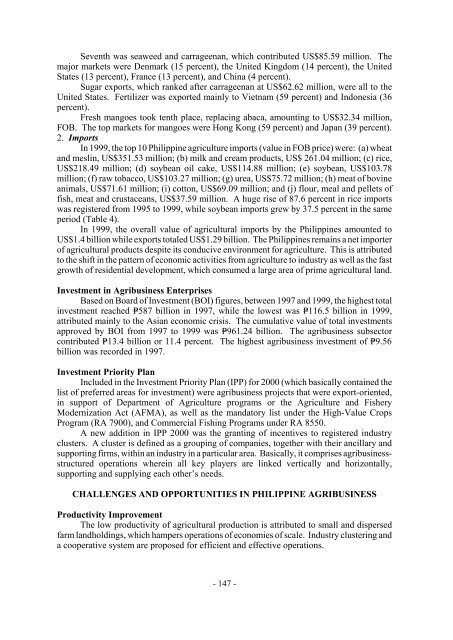Development of Agribusiness Enterprises - Asian Productivity ...
Development of Agribusiness Enterprises - Asian Productivity ...
Development of Agribusiness Enterprises - Asian Productivity ...
Create successful ePaper yourself
Turn your PDF publications into a flip-book with our unique Google optimized e-Paper software.
Seventh was seaweed and carrageenan, which contributed US$85.59 million. The<br />
major markets were Denmark (15 percent), the United Kingdom (14 percent), the United<br />
States (13 percent), France (13 percent), and China (4 percent).<br />
Sugar exports, which ranked after carrageenan at US$62.62 million, were all to the<br />
United States. Fertilizer was exported mainly to Vietnam (59 percent) and Indonesia (36<br />
percent).<br />
Fresh mangoes took tenth place, replacing abaca, amounting to US$32.34 million,<br />
FOB. The top markets for mangoes were Hong Kong (59 percent) and Japan (39 percent).<br />
2. Imports<br />
In 1999, the top 10 Philippine agriculture imports (value in FOB price) were: (a) wheat<br />
and meslin, US$351.53 million; (b) milk and cream products, US$ 261.04 million; (c) rice,<br />
US$218.49 million; (d) soybean oil cake, US$114.88 million; (e) soybean, US$103.78<br />
million; (f) raw tobacco, US$103.27 million; (g) urea, US$75.72 million; (h) meat <strong>of</strong> bovine<br />
animals, US$71.61 million; (i) cotton, US$69.09 million; and (j) flour, meal and pellets <strong>of</strong><br />
fish, meat and crustaceans, US$37.59 million. A huge rise <strong>of</strong> 87.6 percent in rice imports<br />
was registered from 1995 to 1999, while soybean imports grew by 37.5 percent in the same<br />
period (Table 4).<br />
In 1999, the overall value <strong>of</strong> agricultural imports by the Philippines amounted to<br />
US$1.4 billion while exports totaled US$1.29 billion. The Philippines remains a net importer<br />
<strong>of</strong> agricultural products despite its conducive environment for agriculture. This is attributed<br />
to the shift in the pattern <strong>of</strong> economic activities from agriculture to industry as well as the fast<br />
growth <strong>of</strong> residential development, which consumed a large area <strong>of</strong> prime agricultural land.<br />
Investment in <strong>Agribusiness</strong> <strong>Enterprises</strong><br />
Based on Board <strong>of</strong> Investment (BOI) figures, between 1997 and 1999, the highest total<br />
investment reached P=587 billion in 1997, while the lowest was P=116.5 billion in 1999,<br />
attributed mainly to the <strong>Asian</strong> economic crisis. The cumulative value <strong>of</strong> total investments<br />
approved by BOI from 1997 to 1999 was P=961.24 billion. The agribusiness subsector<br />
contributed P=13.4 billion or 11.4 percent. The highest agribusiness investment <strong>of</strong> P=9.56<br />
billion was recorded in 1997.<br />
Investment Priority Plan<br />
Included in the Investment Priority Plan (IPP) for 2000 (which basically contained the<br />
list <strong>of</strong> preferred areas for investment) were agribusiness projects that were export-oriented,<br />
in support <strong>of</strong> Department <strong>of</strong> Agriculture programs or the Agriculture and Fishery<br />
Modernization Act (AFMA), as well as the mandatory list under the High-Value Crops<br />
Program (RA 7900), and Commercial Fishing Programs under RA 8550.<br />
A new addition in IPP 2000 was the granting <strong>of</strong> incentives to registered industry<br />
clusters. A cluster is defined as a grouping <strong>of</strong> companies, together with their ancillary and<br />
supporting firms, within an industry in a particular area. Basically, it comprises agribusinessstructured<br />
operations wherein all key players are linked vertically and horizontally,<br />
supporting and supplying each other’s needs.<br />
CHALLENGES AND OPPORTUNITIES IN PHILIPPINE AGRIBUSINESS<br />
<strong>Productivity</strong> Improvement<br />
The low productivity <strong>of</strong> agricultural production is attributed to small and dispersed<br />
farm landholdings, which hampers operations <strong>of</strong> economies <strong>of</strong> scale. Industry clustering and<br />
a cooperative system are proposed for efficient and effective operations.<br />
- 147 -
















